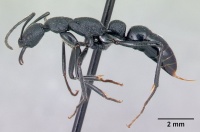Leptogenys manja
| Leptogenys manja | |
|---|---|

| |
| Scientific classification | |
| Kingdom: | Animalia |
| Phylum: | Arthropoda |
| Class: | Insecta |
| Order: | Hymenoptera |
| Family: | Formicidae |
| Subfamily: | Ponerinae |
| Tribe: | Ponerini |
| Genus: | Leptogenys |
| Species group: | incisa |
| Species complex: | imerinensis |
| Species: | L. manja |
| Binomial name | |
| Leptogenys manja Rakotonirina & Fisher, 2014 | |
Leptogenys manja occurs in lowland rainforests of Ambodiriana Reserve at 125 m and the RS Manombo at 30 m. In lowland rainforests, workers of L. manja forage through the leaf litter and on lower vegetation.
Identification
A member of the imerinensis complex of the incisa species group. Rakotonirina and Fisher (2014) - Worker. Peg-like setae present on the anteromedial clypeal lobe, projecting anteriorly from above the much narrower semi-translucent lamella; width of lamella less than the minimum diameter of antennal scape; scape relatively long (SI 136–140), more than apical third portion extending beyond posterior cephalic margin. Mandible generally smooth apart from short striation and sparse punctures; blade narrow and not strongly curved at the base, inner margin concave. Dorsum of mesosoma composed of three segments.
Keys including this Species
Distribution
Latitudinal Distribution Pattern
Latitudinal Range: -16.6723° to -16.6723°.
| North Temperate |
North Subtropical |
Tropical | South Subtropical |
South Temperate |
- Source: AntMaps
Distribution based on Regional Taxon Lists
Malagasy Region: Madagascar (type locality).
Distribution based on AntMaps
Distribution based on AntWeb specimens
Check data from AntWeb
Countries Occupied
| Number of countries occupied by this species based on AntWiki Regional Taxon Lists. In general, fewer countries occupied indicates a narrower range, while more countries indicates a more widespread species. |

|
Estimated Abundance
| Relative abundance based on number of AntMaps records per species (this species within the purple bar). Fewer records (to the left) indicates a less abundant/encountered species while more records (to the right) indicates more abundant/encountered species. |

|
Biology
|
Castes
Nomenclature
The following information is derived from Barry Bolton's Online Catalogue of the Ants of the World.
- manja. Leptogenys manja Rakotonirina & Fisher, 2014: 90, figs. 40B, 48A, 50B, 51B, 103, 119 (w.) MADAGASCAR.
Unless otherwise noted the text for the remainder of this section is reported from the publication that includes the original description.
Description
Worker
(2 specimens). HW: 1.57–1.59, HL: 1.85–1.86, CI: 85, SL: 2.16–2.20, SI: 136–140, PW: 1.23–1.29, WL: 3.32–3.47, PNH: 0.92–0.96, PNL: 1.04–1.06, PNW: 0.87–0.90, DNI: 82–86, LNI: 87–92.
Head fairly long, much wider at front than behind. Eye strongly protruding from head surface. Antennal scape distinctly long, more than one-third of its length extending beyond posterior cephalic margin. Anterior margin of clypeus medially broadly angulate with a blunt apex; semi-translucent membrane on lateral and anteromedian margin of clypeus narrower than minimum diameter of scape. Mandible long and slender, not strongly curved at base; inner margin concave, apical tooth obtuse and not reaching anterior margin of clypeus when mandibles close. Hypostomal teeth short and not visible when head in full-face view. In dorsal view, mesosoma characterized by three visible segments; metanotal groove impressed; in lateral view, dorsum of propodeum slightly convex and relatively long and low, rounding to short declivitous surface. With petiole in profile, node roughly elongate, anterior face vertical and posterior margin inclined anteriorly and rounding with convex dorsal margin. Strong constriction present between third and fourth abdominal segments. Mandible smooth, with effaced longitudinal striation and sparse punctures. Head and mesosoma densely reticulate-rugose dorsally; propodeal declivity transversely rugose. Node of petiole laterally reticulate-rugose; the dorsum mostly finely microreticulate, interspersed with widely spaced, large punctures. Standing hairs and pubescence present on dorsum of body. Body black, with ferruginous-brown apex of appendages and tip of gaster.
Type Material
Holotype worker: Madagascar, Toamasina: Réserve Ambodiriana, 4.8 km 306° Manompana, along Manompana River, -16.6723, 49.7012, 125 m, rainforest, ground forager, 19 Nov 2005 (B.L. Fisher et al.), collection code: BLF12837, specimen code: CASENT0068233 (California Academy of Sciences).
References
- Rakotonirina, J.C. & Fisher, B.L. 2014. Revision of the Malagasy ponerine ants of the genus Leptogenys Roger (Hymenoptera: Formicidae). Zootaxa 3836, 1-163.
References based on Global Ant Biodiversity Informatics
- Rakotonirina J. C., and B. L. Fisher. 2014. Revision of the Malagasy ponerine ants of the genus Leptogenys Roger (Hymenoptera: Formicidae). Zootaxa 3836 (1): 001163.

